Key takeaways:
- Rigging is essential for 3D animation, involving detailed setup of bones and controls to create realistic movement and connection between viewer and character.
- Choosing the right rigging software is crucial; factors like compatibility and user interface significantly impact the efficiency and quality of the rigging process.
- Effective troubleshooting of common rigging issues, such as weight distribution and control responsiveness, can greatly enhance the fluidity and quality of animations.
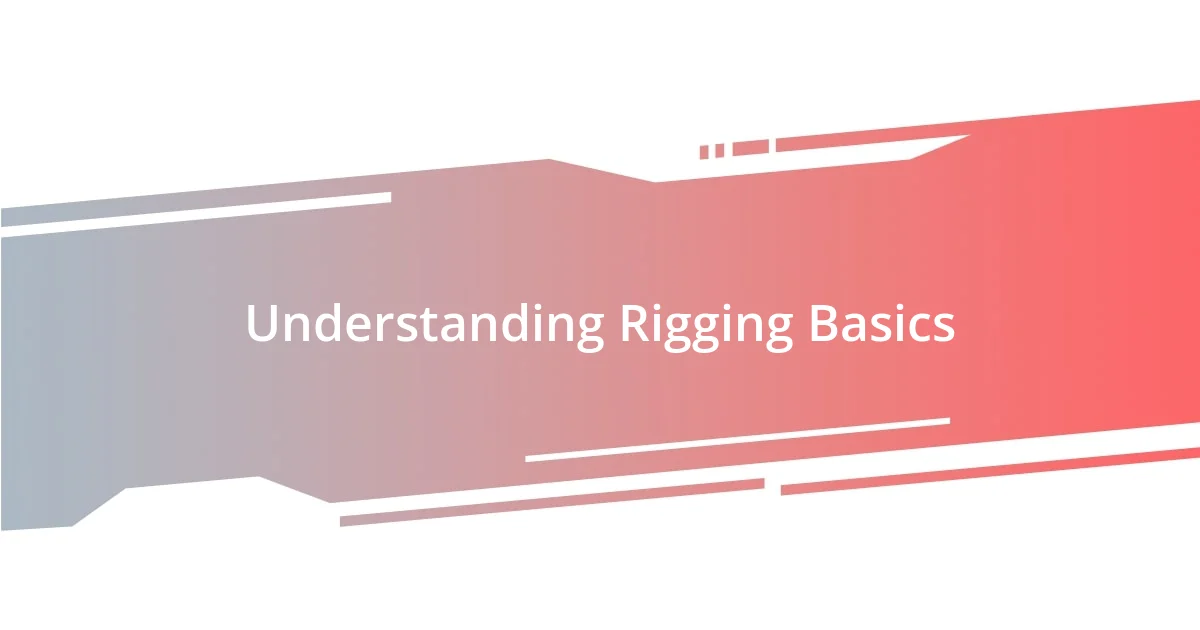
Understanding Rigging Basics
Rigging is the backbone of 3D animation, enabling movement by setting up a skeletal structure for your models. I remember the first time I created a character rig – it felt like giving life to a digital puppet. Seeing my model move seamlessly after hours of tweaking joints and weights was exhilarating.
At its core, rigging involves creating a complex hierarchy of bones and controls. Each bone serves as a pivot point, allowing different parts of the model to articulate naturally. Have you ever watched a character in a game or film and wondered how the subtleties of their movements are achieved? That’s the magic of well-executed rigging.
The process requires patience and a keen eye for detail, as every small adjustment can significantly impact how the model behaves. I’ve often found myself lost in the nuances of rotation and scaling, trying to get the perfect range of motion. It’s all about making the movement feel believable and organic, creating a connection between the viewer and the character. Isn’t it fascinating how much thought goes into those seemingly simple actions?
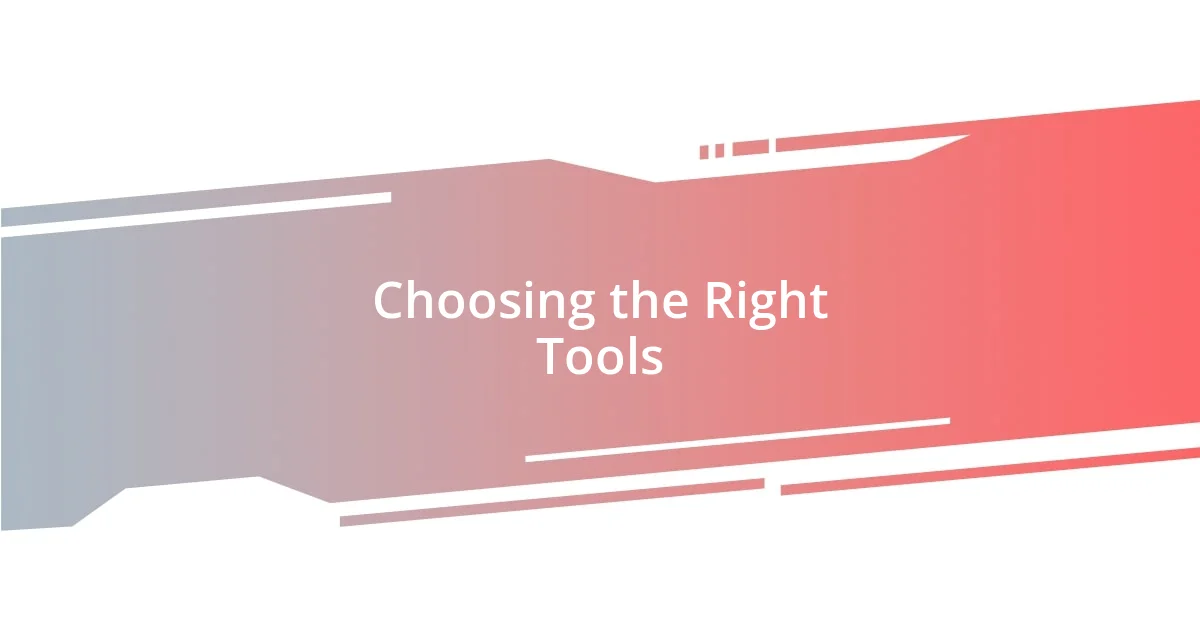
Choosing the Right Tools
Choosing the right tools for rigging is crucial. There’s a wide variety of software available, each with unique features that can greatly influence the rigging process. I remember a time when I spent hours trying to figure out the best workflow in software that ultimately wasn’t suited for my project. The right tool can save you time and frustration while ensuring high-quality results.
When comparing different rigging tools, it’s essential to consider factors such as compatibility, user interface, and flexibility. For instance, I’ve dabbled in both Blender and Maya, and while Blender has an intuitive freeform approach, Maya’s robust features and animation libraries offer unmatched depth. These nuances, while sometimes subtle, can make a significant difference in your final output.
Ultimately, it comes down to personal preference and the specific needs of your project. I’ve learned the hard way that investing time into finding tools that resonate with my creative workflow pays off tenfold. After all, when you’re comfortable with your tools, rigging becomes a more enjoyable and efficient experience.
| Software | Features |
|---|---|
| Maya | Industry-standard, advanced rigging tools |
| Blender | Free, user-friendly interface, great for indie projects |
| 3ds Max | Robust modeling and rigging features |
| Houdini | Powerful procedural rigging capabilities |
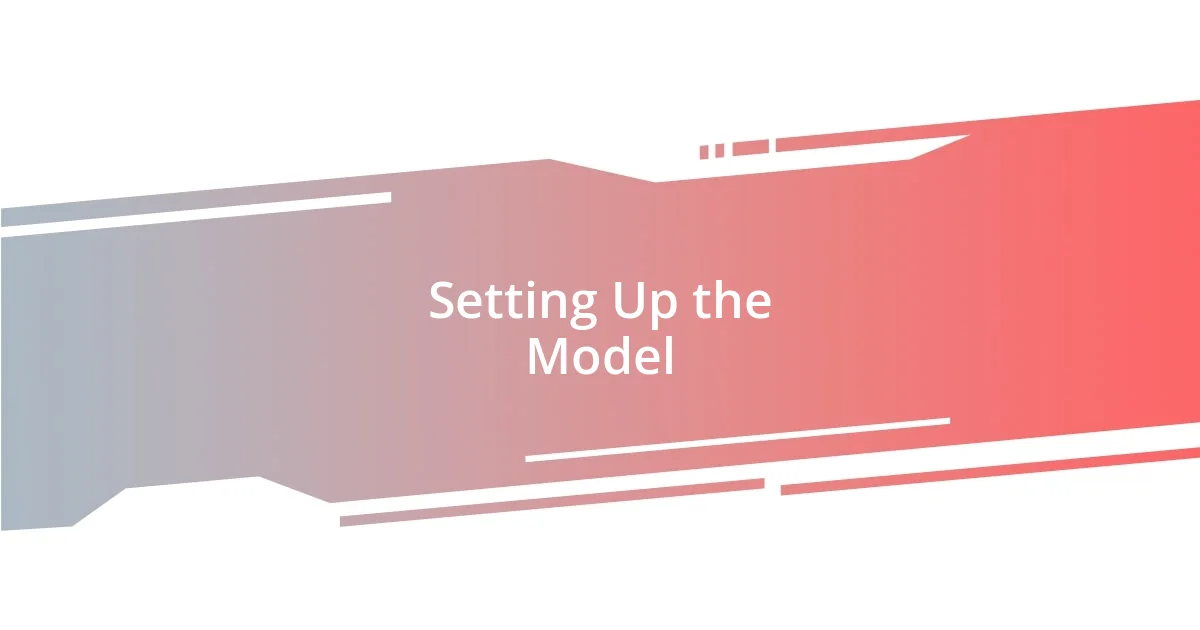
Setting Up the Model
Setting up your model is a crucial step in the rigging process. It’s like laying the foundation of a house – if it’s not strong and precise, everything built on it will suffer. I remember a project where I had to start from scratch due to misalignments in the initial setup. Trust me, spending that extra hour to ensure everything is perfectly aligned is worth it in the long run.
Here are a few key steps to consider during this phase:
- Model Clean-Up: Ensure the mesh is free of non-manifold edges and unnecessary vertices.
- Topology Check: A clean topology will make deformation smoother. I often visualize how the mesh will move and sculpt accordingly.
- Position Bones: Align bones with the model’s structure—think of it like fitting joints to muscles.
- Naming Conventions: Use clear and consistent naming for bones and controls; it saves so much headache later on.
- Scale Consistency: Make sure your model is at an appropriate scale before rigging; it affects weight painting and movement.
Getting this right not only makes the rigging process smoother but also directly influences the quality of the final animation. The blend of technical precision and artistic flair—it’s an exhilarating challenge that keeps me coming back for more.
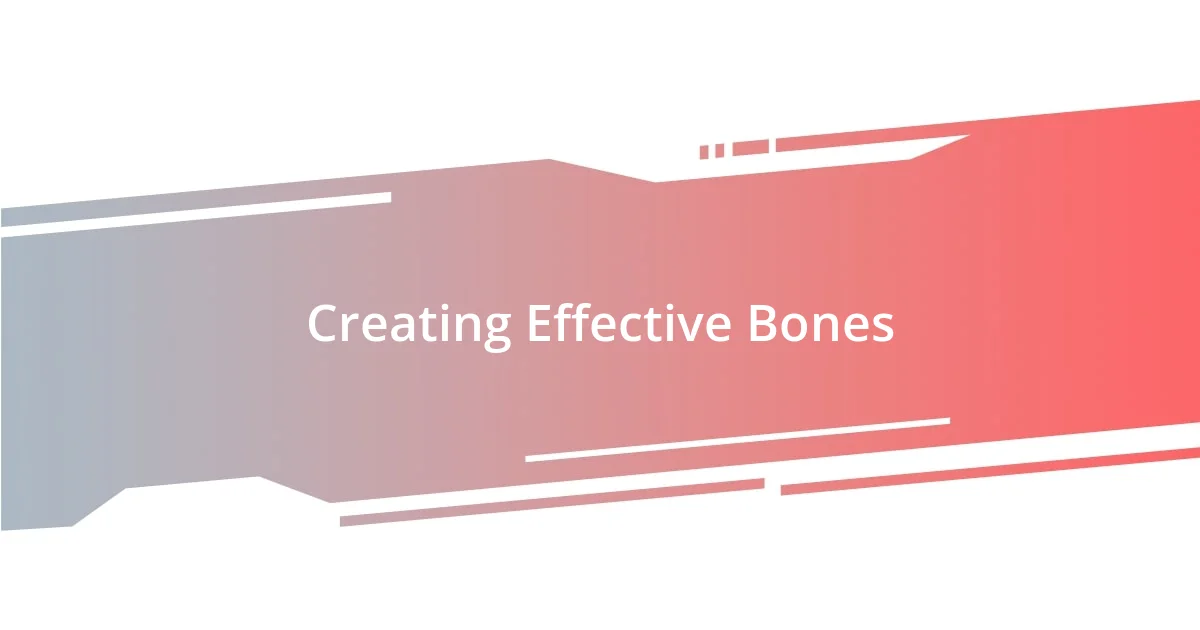
Creating Effective Bones
Creating an effective bone structure is essential for realistic movement in your models. I find that the placement of bones can significantly affect the overall animation, almost like a puppeteer pulling strings. During one project, I positioned a bone too close to a joint, which resulted in unnatural bending. It was a simple oversight, but it taught me the importance of thoughtful placement right from the start.
When it comes to bone hierarchy, I’ve learned that organizing bones logically not only aids in animation but also keeps things tidy in the software. A well-structured hierarchy makes it easier to isolate movements; I often think of it as a family tree where each bone belongs to a specific lineage. Have you ever tried animating a model with a jumbled bone structure? It can be frustrating! I once faced that issue and realized that taking time to establish a clear hierarchy upfront can save countless hours of headache later.
Additionally, I emphasize the importance of joint orientation. Properly oriented joints enhance rotation and provide more natural movement. I recall a time where my character’s arm rotations were awkward because the joints weren’t aligned correctly. It was a valuable lesson to tackle joint orientation early in the rigging process. When you ensure joints are aligned with your model, it not only elevates the animation quality but also enhances your creativity, allowing for more fluid motion.
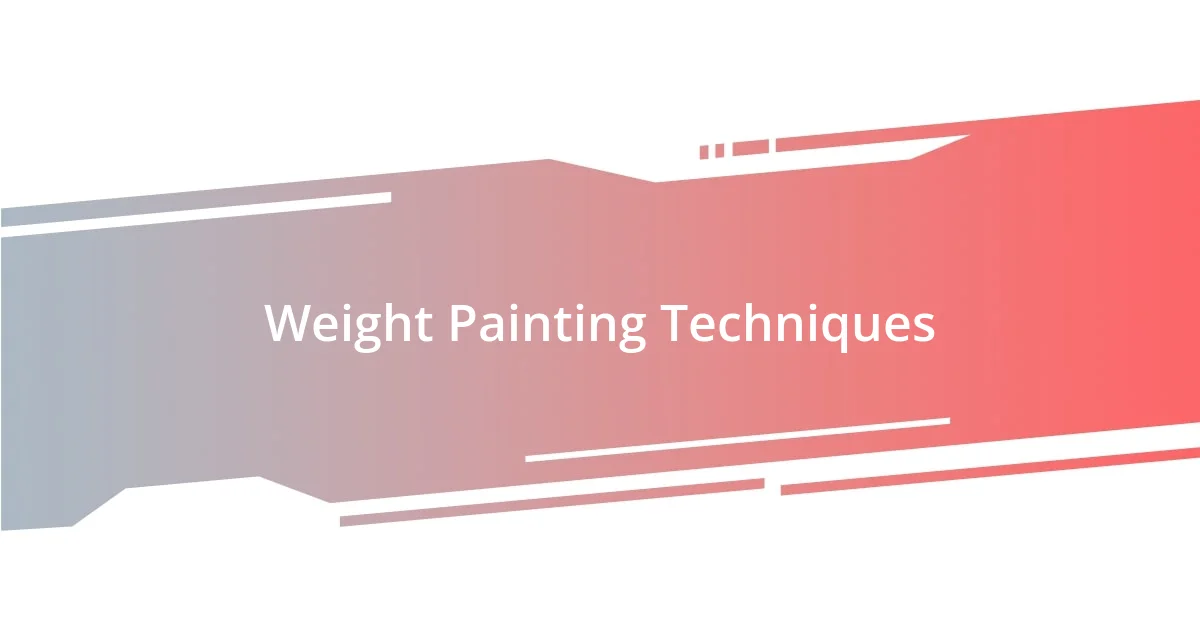
Weight Painting Techniques
Weight painting is one of those steps in rigging that can truly make or break an animation, and I’ve learned that mastering it takes practice and patience. I remember the first time I dabbled in weight painting; I was so eager to see my model move that I painted weights without fully understanding their influence on deformations. It resulted in some bizarre, almost nightmarish movements—think of a doll being pulled by invisible strings! Now, I focus on gradually adjusting weights, using tools that allow me to preview how changes will affect the mesh before committing.
One technique I swear by is using mirror weights when working on symmetrical models. It saves so much time and ensures consistency across both sides. I recall another project where I painstakingly painted weights on one arm, only to realize that I had to redo the same work on the other! That experience taught me that leveraging symmetry tools can streamline the process. Sometimes I question why I didn’t use this technique from the start—it’s such a game changer!
Furthermore, I often utilize Blender’s gradient painting mode for smoother transitions in weights. The first time I saw how it blurred the weights around joints, I was genuinely impressed. It feels like you’re treating the mesh like a canvas, layering colors smoothly to create life-like motions. Have you ever experienced the joy of watching a well-weighted character move fluidly? It’s incredibly rewarding and reminds me of why I love this craft. Ultimately, finding the right balance in weight painting is an art form in itself, one that can turn a good model into an exceptional one.
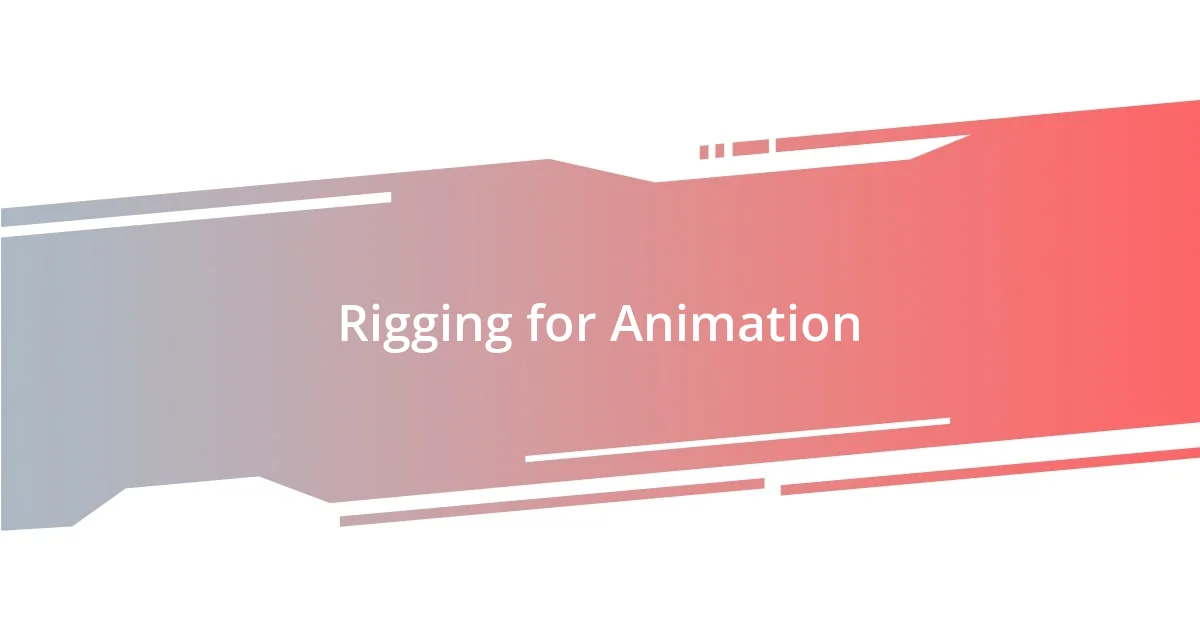
Rigging for Animation
When diving into rigging for animation, I often think about the pivotal role of defining control shapes. In my experience, having intuitive controls can mean the difference between a tedious animation process and a smooth, enjoyable one. I remember one time spending hours wrestling with a character’s face because the controls were scattered and hard to understand. It was a lesson that reinforced my belief: well-designed control shapes empower artists and streamline the animation workflow.
Another critical aspect I focus on is the skinning process. A strong skinning technique allows the mesh to deform in a way that feels organic and lifelike. I once attended a workshop where the instructor emphasized pinning certain areas to maintain volume, and it was a real game-changer for me. Have you ever noticed how amateur animations can often feel stiff or awkward? This is often a result of poor skinning. By being mindful of volume and maintaining a soft, fluid feel, I’ve been able to achieve much more natural results.
Finally, I can’t stress enough the importance of testing animations throughout the rigging process. While it’s tempting to finish the rig completely before animating a single frame, I’ve learned that iterative testing can reveal issues you might miss otherwise. I remember the excitement of watching my rig work in motion for the first time—only to see a character’s legs twist in a way that defied physics! It highlighted the necessity of continuous testing. It not only helps to identify problems early but also fuels creativity as you discover new possibilities in movement.
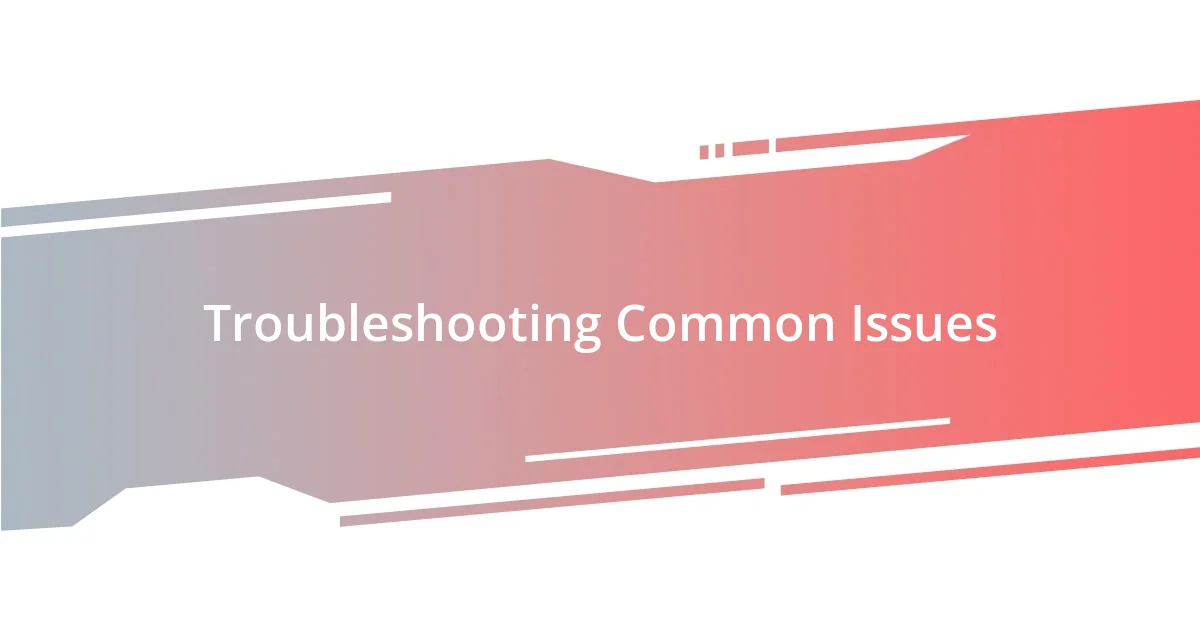
Troubleshooting Common Issues
When troubleshooting common issues in rigging, I often find myself addressing problems related to the deformation of the mesh. I remember one specific instance when I was puzzled by my model’s shoulder popping during arm raises. After some head-scratching, I discovered that the weight distribution was uneven. Have you ever faced that annoying moment where your model behaves like a marionette? I realized that examining the weight maps and refining them was the key to achieving fluid motion.
Another challenge I frequently encounter involves the control rig itself. I’ve been in situations where the controls felt unresponsive or clunky, almost like driving a car with a faulty steering wheel. In those moments, I take a step back to ensure everything is linked correctly. Sometimes, it just takes a fresh perspective, or a second look at the hierarchy, to make those controls work like a dream. Have you noticed of how much easier animation feels when you have responsive controls that align with your expectations?
Lastly, let’s not overlook the importance of checking for any geometry issues, like overlapping vertices or non-manifold edges. I vividly recall working late into the night, engrossed in a project, only to have it crash because of a rogue face on the model. Ever had that heart-sinking feeling when all your hard work seems on the brink of collapse? By running clean-up tools and ensuring proper geometry before finalizing the rig, I’ve avoided many potential headaches down the road. Taking that extra time to troubleshoot can prevent a multitude of issues in the smoother continuation of your project.















